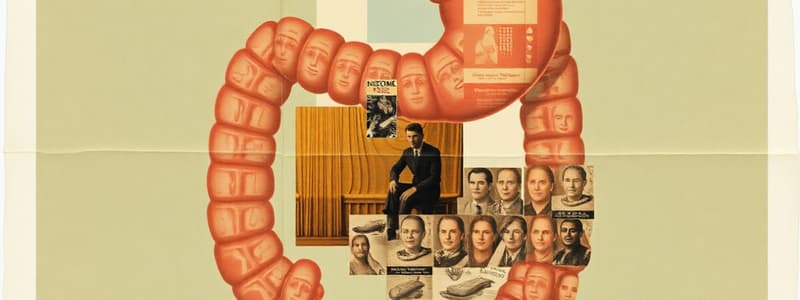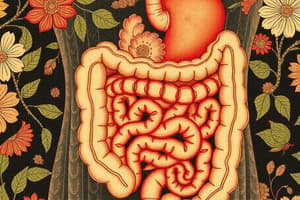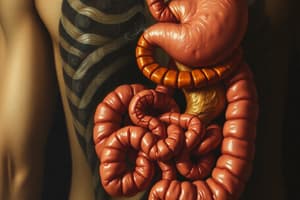Podcast
Questions and Answers
What is the primary role of bile salts in fat digestion?
What is the primary role of bile salts in fat digestion?
- To hydrolyze triglycerides into monoglycerides
- To absorb fatty acids and monoglycerides in the small intestine
- To form water-soluble chylomicrons in the epithelial cells
- To emulsify large fat globules into smaller fat droplets (correct)
What happens to monoglycerides and free fatty acids after they diffuse through the lipid bilayer of epithelial cells?
What happens to monoglycerides and free fatty acids after they diffuse through the lipid bilayer of epithelial cells?
- They remain unchanged and enter the bloodstream
- They are converted into bile salts
- They are excreted as waste products
- They are resynthesized into triglycerides (correct)
What is one main function of the large intestine?
What is one main function of the large intestine?
- Produce pancreatic enzymes for digestion
- Drying and storage of indigestible substances (correct)
- Store bile salts for fat digestion
- Absorb carbohydrates and proteins
What is primarily absorbed in the large intestine?
What is primarily absorbed in the large intestine?
How are chylomicrons formed in the epithelial cells of the small intestine?
How are chylomicrons formed in the epithelial cells of the small intestine?
What is the ultimate pathway for chylomicrons after being extruded from the epithelial cells?
What is the ultimate pathway for chylomicrons after being extruded from the epithelial cells?
Which types of beneficial substances are produced by bacteria in the large intestine?
Which types of beneficial substances are produced by bacteria in the large intestine?
What is the mechanism by which monoglycerides and fatty acids leave micelles?
What is the mechanism by which monoglycerides and fatty acids leave micelles?
What is the primary function of the gastrointestinal (GI) system?
What is the primary function of the gastrointestinal (GI) system?
Which of the following processes is NOT a primary function of the GI system?
Which of the following processes is NOT a primary function of the GI system?
What role do the interstitial cells of Cajal serve in the digestive system?
What role do the interstitial cells of Cajal serve in the digestive system?
What is the main function of pepsin in the digestive system?
What is the main function of pepsin in the digestive system?
Which component primarily protects the stomach lining from hydrochloric acid?
Which component primarily protects the stomach lining from hydrochloric acid?
During which phase of gastric secretion is the presence of food in the stomach most critical?
During which phase of gastric secretion is the presence of food in the stomach most critical?
Which of the following is a characteristic of the small intestine?
Which of the following is a characteristic of the small intestine?
Which pancreatic secretions play a crucial role in neutralizing gastric acid?
Which pancreatic secretions play a crucial role in neutralizing gastric acid?
What is the primary nutrient absorbed in the small intestine?
What is the primary nutrient absorbed in the small intestine?
What type of movement in the digestive tract primarily facilitates the mixing of food with digestive juices?
What type of movement in the digestive tract primarily facilitates the mixing of food with digestive juices?
Which of the following statements about the alimentary canal is true?
Which of the following statements about the alimentary canal is true?
Which process involves the transfer of small digested units into the blood or lymph?
Which process involves the transfer of small digested units into the blood or lymph?
What is the role of the serosa in the wall structure of the alimentary canal?
What is the role of the serosa in the wall structure of the alimentary canal?
Flashcards
Fat Emulsification
Fat Emulsification
The process of breaking down large fat globules into smaller droplets, increasing surface area for enzyme action.
Pancreatic Lipase
Pancreatic Lipase
An enzyme produced by the pancreas that breaks down triglycerides into monoglycerides and fatty acids.
Micelles
Micelles
Small, water-soluble structures formed by bile salts that transport monoglycerides and fatty acids to the intestinal lining.
Fat Absorption
Fat Absorption
Signup and view all the flashcards
Chylomicrons
Chylomicrons
Signup and view all the flashcards
Colon
Colon
Signup and view all the flashcards
Appendix
Appendix
Signup and view all the flashcards
Large Intestine Absorption
Large Intestine Absorption
Signup and view all the flashcards
Digestion
Digestion
Signup and view all the flashcards
Absorption
Absorption
Signup and view all the flashcards
Motility
Motility
Signup and view all the flashcards
Secretion
Secretion
Signup and view all the flashcards
Alimentary canal
Alimentary canal
Signup and view all the flashcards
Accessory Digestive Organs
Accessory Digestive Organs
Signup and view all the flashcards
Mucosa
Mucosa
Signup and view all the flashcards
Submucosa
Submucosa
Signup and view all the flashcards
Muscularis externa
Muscularis externa
Signup and view all the flashcards
Serosa
Serosa
Signup and view all the flashcards
Mastication
Mastication
Signup and view all the flashcards
Deglutition
Deglutition
Signup and view all the flashcards
Stomach
Stomach
Signup and view all the flashcards
Duodenum
Duodenum
Signup and view all the flashcards
Pancreas
Pancreas
Signup and view all the flashcards
Study Notes
Gastrointestinal System 1
- The GI system is a group of organs working together to break down ingested food into smaller, absorbable molecules.
- These molecules are then absorbed into the blood for distribution to all cells in the body.
- The GI system performs five basic processes: motility, secretion, digestion, absorption, and storage/elimination of indigestible food.
Motility
- Motility involves muscular contractions that mix and move digestive tract contents.
- Two types of motility are propulsive (pushing contents forward) and mixing (mixing food with juices, aiding digestion and absorption).
Secretion
- The GI tract secretes digestive juices in response to specific neural or hormonal stimulation.
- These juices consist of water, electrolytes, and specific organic constituents (enzymes, mucus etc).
- Exocrine secretions are released into the gut lumen (e.g., water, HCl, bicarbonate, bile, enzymes like lipase, pepsin, amylase, trypsin, and histamine).
- Endocrine secretions enter the bloodstream (e.g., gastrin, secretin, CCK, VIP, and somatostatin).
Digestion
- Chemical digestion is the breakdown of complex food into smaller, absorbable units through enzyme-mediated hydrolysis.
- Examples of complex foodstuffs and their absorbable units: carbohydrates into monosaccharides, proteins into amino acids, and fats into glycerol and fatty acids.
Absorption
- Absorption is the transfer of small digested units, water, vitamins, and electrolytes from the GI tract into blood or lymph.
- Absorption occurs primarily in the small intestine.
Functional Anatomy of the Gastrointestinal (Digestive) System
- The digestive tract is a continuous tube from the mouth to the anus (approx. 30 feet).
- It consists of the mouth, pharynx, esophagus, stomach, small intestine (duodenum, jejunum, ileum), large intestine (cecum, colon, rectum), and anus.
- Accessory organs include salivary glands, liver, pancreas, and gallbladder.
Gross Functional Organization of the Alimentary Canal
- Divided into three main parts:
- Upper part (mouth, esophagus, stomach): food intake, receptacle, initial digestion.
- Middle part (small intestine): main site of digestion and absorption (duodenum, jejunum, ileum).
- Lower part (large intestine): storage and elimination of waste.
Wall Structure of the Alimentary Canal
- The wall consists of four layers:
- Mucosa (innermost layer): moist, folded lining of epithelial cells, connective tissue, smooth muscle cells; protection against pathogens, secretes mucus, digestive enzymes, and hormones.
- Submucosa (beneath the mucosa): dense connective tissue that provides distensibility and elasticity, glands secrete digestive enzymes.
- Muscularis externa (beneath the submucosa): consists of inner circular and outer longitudinal smooth muscle layers, myenteric plexus for mixing and movement.
- Serosa (outermost layer): connective tissue and epithelial covering; continuous with the mesentery (a membrane that suspends the intestines); secretes a watery fluid to lubricate the digestive system.
Complex Extrinsic & Intrinsic Regulation of Digestive Function
- Regulated through interstitial cells of Cajal (pacemaker cells), intrinsic nerve plexuses (ENS), extrinsic nerves (ANS), gastrointestinal hormones, and local sensory receptors.
- Short reflexes occur within the digestive tract, and long reflexes involve the CNS.
Digestive Processes - From Mouth to Stomach
- Mastication (chewing): aids in mechanical breakdown, mixes food with saliva (containing amylase for starch digestion), moistens/lubricates food and exerts antibacterial effect.
- Deglutition (swallowing): involves oropharyngeal and esophageal stages.
Swallowing - Oropharyngeal Stage
- Bolus movement from mouth to pharynx.
- Epiglottis moves to cover glottis preventing food entry in trachea( during swallowing)
Swallowing - Oesophageal Stage
- Bolus passage through esophagus.
- Muscles contract propelling the bolus down.
The Stomach (Details)
- J-shaped sac-like chamber, most distensible part of the GI tract.
- Stores, secretes gastric juice (acid, mucus, intrinsic factor, and digestive enzymes - pepsin, lipase).
- Mixes food with gastric juice, initiates protein and fat digestion.
- Kills bacteria and moves chyme into duodenum
Gastric Mucosal Folds, Gastric Pits, and Gastric Glands
- Gastric mucosa contains folds and pits. Important glands in gastric mucosa (e.g., chief cells, parietal cells, mucous neck cells, ECL cells).
Structure Of Gastric Gland
- Different sections of the gastric gland produce different secretions(e.g., mucous layer, surface mucous cells, mucous neck cells, parietal cells and Chief cells).
The Stomach Mucosa & Gastric Glands
- Different cells in the stomach mucosa secrete various products.
Gastric Glands - Important Gastric Secretory Products
- Provides detailed information about different sources and functions of gastric secretory products (e.g., hydrochloric acid, intrinsic factor, pepsinogen, mucus, bicarbonates, trefoil factors, histamine, gastrin, gastrin-releasing peptide (GRP), acetylcholine (ACh), and somatostatin).
Pepsinogen Activation in the Stomach
- Pepsinogen is converted to pepsin by HCl, activating protein digestion
Mechanism of Gastric HCI Secretion
- Explains the processes that occur in parietal cells for HCl secretion
Parietal Cell - Receptor Activation of the Proton Pump
- Shows receptors and signal transduction cascades activating the proton pump for HCl production.
Control of Gastric Secretion
- Describes the cephalic phase (head), gastric phase (stomach) and intestinal phase (small intestine).
- Identifies factors that regulate gastric secretion in these phases.
- Excitatory and inhibitory duodenal phases
- Inhibitory mechanisms for controlling gastric secretion
Digestion & Absorption in the Stomach
- Carbohydrate digestion continues (with some inhibition), but it's primarily proteins being partially digested by pepsin in the stomach antrum.
- Water and small molecules (aspirin and alcohol) are absorbed here.
The Gastric Mucosal Barrier
- Explains the components of the gastric mucosal barrier (mucus coating, tight junctions, and HCO3-rich mucus).
- How it protects the stomach from HCl damage
Digestion & Absorption in the Small Intestine
- Details small intestine's role in digestion and absorption
- Discusses the different segments (duodenum, jejunum, ileum) and their functions.
- Describes structure-function relationships in the small intestine (e.g., folds, villi, microvilli).
Absorption in Small Intestine
- Details absorption in duodenum & jejunum, and ileum
- Types of nutrients absorbed and methods for absorption.
Carbohydrate, Protein & Fat Digestion
- Shows the enzymes involved in digesting carbohydrates, proteins, and fats.
- How these nutrients are broken down during digestion.
Carbohydrate Digestion
- Details steps of carbohydrate digestion starting from polysaccharides to monosaccharides.
- Shows where the various enzymes that digest carbs are active in digestion process.
Carbohydrate Absorption
- Describes the absorption process for carbohydrates from the digestive tract into small intestine cells and blood.
Protein Digestion
- Detail steps of protein digestion
- Enzyme and location involved
Protein Absorption
- Explains the absorption of proteins from the digestive tract into absorption cells and blood .
Fat Digestion and Absorption
- Discusses fat digestion
- Role of bile salts in emulsification, pancreatic lipase in breakdown
The Large Intestine
- Role, functions and structure of the colon, caecum, appendix and rectum.
- Minor absorptive function
- Bacteria in the colon and their role
- Production of Vitamin K and short chain fatty acids
The Liver & Hepatic Portal Circulation
- How blood is carried to the liver from the small digestive tract and also from the arteries.
- The circulation of blood from the liver via the hepatic vein.
The Liver
- The liver’s size and role as the largest gland and role in bile production.
- Bile's function as a fat emulsifier
- Breakdown and secretion of bile.
Fat Emulsification by Bile Salts
- Diagram and description showing how bile salts emulsify fats.
Control of Bile Release.
- Explaining the mechanism of bile release by cholecystokinin from the digestive tract(Duodenum) in responses to entry of acidic chyme, fatty chyme into the small intestine.
Enterohepatic Circulation of Bile Salts
- Describes how bile salts are recycled.
Enterohepatic Circulation of Bile Salts
- Explains the loop through which bile salts recirculate after being absorbed.
Iron Absorption
- The process by which iron or heme iron is absorbed into the blood stream(small intestine) from the diet.
- Process of iron absorption, and the role of different proteins in the process.
- Explain where absorbed iron is stored and how it is eliminated when not needed.
Recommended Reading
- List of recommended textbooks.
Studying That Suits You
Use AI to generate personalized quizzes and flashcards to suit your learning preferences.




